Navegue con comodidad
Los barcos a motor son obras maestras de la ingeniería. Contienen toda la comodidad de un hogar en el espacio compacto de un barco. Dondequiera que vaya, querrá disfrutar al máximo de este lujo que tanto le ha costado conseguir. Victron le proporciona una red de alimentación inteligente que se adapta a cualquier dificultad con la que se pueda encontrar mientras navega. De modo que puede relajarse en la cubierta.
A lo mejor va a ir de isla en isla durante el fin de semana o piensa quedarse anclado en una bonita bahía una semana entera; son sus vacaciones y puede hacer lo que quiera. Esto hace que la solución energética óptima sea diferente para cada embarcación y para cada propietario. Con Victron puede alimentar cualquier plan, pero a modo de ejemplo hemos ilustrado a continuación un perfil energético “normal” y otro “superior” para un barco a motor “medio”.
Echemos un vistazo a su Plan energético óptimo que hará todo esto posible.
Consumo
¿Cuánto necesita?
Un barco a motor no estaría completo sin un montón de equipos eléctricos. La mayoría de los elementos necesarios para operar el barco necesitan CC y los aparatos (domésticos) más grandes necesitan CA. ¿Cuánta energía supone todo esto? No se fije solo en los vatios. Un microondas puede necesitar 1000 vatios, pero solo durante 4 minutos. Un refrigerador/congelador puede necesitar tan solo 100 vatios, pero está encendido las 24 horas del día.
A modo de orientación hemos diseñado dos ejemplos de sistema en función de un uso “normal” y “superior”.
Ejemplo 1
El microondas utiliza 1000 W por hora, pero solo está funcionando durante 4 minutos
1000W / 60 x 4 = 0.067 kWh / day
Ejemplo 2
El refrigerador/congelador utiliza 84 W por hora, pero funciona durante todo el día (normalmente refrigerando la mitad del día).
84 W x 24 h/2 = 1 kWh/día
Almacenamientoy conversión
¿Cuánta energía debe almacenarse?
Un barco a motor necesita un buen almacenamiento de energía y una potente conversión a 230 V. Si carga una bancada de baterías con los motores, no será necesario encender el ruidoso generador cuando esté anclado en medio del mar durante la noche. Puesto que es posible que no se mueva durante unos días, su batería auxiliar debería tener una capacidad amplia. Como regla general, calculamos el almacenamiento de energía considerando 48 horas a bordo sin suministro de energía del puerto/motor/generador/solar.
x 2
La capacidad de almacenamiento de una batería de litio debería ser el doble del consumo diario de energía.
x 4
Debido a su capacidad de descarga un ±50 % inferior, la capacidad de almacenamiento de una batería de plomo-ácido debería ser cuatro veces el consumo diario de energía.
Conversión
El inversor (o inversores) debería estar dimensionado para manejar la carga media de forma continua y ajustarse a la corriente de potencia pico prevista para las cargas, algo que nuestros inversores manejan muy bien (de media, el doble de su corriente continua).
Generación
¿De dónde viene la energía?
Fuentes de energía
Power profile


Perfiles energéticos normal y superior en kWh, en función del consumo diario de energía, que debería estar en equilibrio con la generación.
Baterías de almacenamiento en Ah, duplique la capacidad con baterías de plomo-ácido.
Diagrama del sistema
para un sistema con batería de litio o batería de plomo-ácido
¿Cómo se traducen las consideraciones del diseño del sistema en un sistema sólido?


AC-devices
Everything you would expect in a home can also be found on a motor cruiser. All these devices need AC to run. Think of:
- Entertainment suite
- Television(s)
- Laptop(s)
- Phone chargers
- Fridge and freezer
- Coffeemaker
- Breadmaker
- Dishwasher
- Microwave
- Mixer
- Wine cooler
- Washing machine

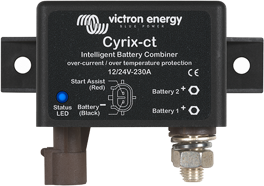
BatteryCombiner
The Cyrix BatteryCombiner is the only safe way to connect the house battery to the starter battery (to start your boat’s engines). With a BatteryCombiner you can charge the house battery from the alternator without running the risk of draining the starter battery (which always should be ready to go). When other sources of power are available (eg. shore/solar/generator power), the Cyrix BatteryCombiner will allow bi-directional charging from the house battery to the starter battery.
When the Voltages of the starter and house batteries are the same, use a Cyrix: its current rating should be equal or bigger than the current rating of the alternator.
If the house battery is Lithium and the alternators Amperage is smaller than the house battery, or when the Voltages of the starter and house battery are different: use a DC-DC converter or Buck-Boost.

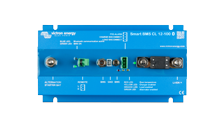
Battery Management Systems
Battery management systems take excellent care of Lithium batteries, protecting the individual cells of LiFePO4 batteries against over voltage, under voltage and over temperature and will shut down or reduce charging (VE.Bus products only) or disconnect the loads when this occurs.
Victron Energy offers several BMS options, in general the VE.Bus BMS and smallBMS signal separate devices to disconnect the charging (Inverter/Chargers, Cyrix-Li, DC-DC chargers) or disconnect the loads (BatteryProtect, Inverter/Charger), the modular Lynx distribution system features the Lynx BMS and other modules for more control over the DC busbar. For vehicles and boats all-in-one functionalities are available in the Smart BMS versions for Victron Lithium batteries, but also include current limiting to protect the alternator from overheating and BatteryProtect-like functionality to shut down the loads when pre-set critical battery conditions are met.
Victron Energy also offers full flexibility when it comes to selecting a third-party off-grid battery bank (and their BMS) of choice. A large number of well supported Lithium battery manufacturers can be easily integrated through the use of a mandatory GX-device. This flexibility enables our customers to perfectly match their off-grid needs for their unique power situation. When working with unsupported brands, a Victron Energy Battery Monitor is required to pass on accurate state of charge readings to the wider system.
Ver todos nuestros sistemas de gestión de baterías
La elección de los profesionales:
Aquí puede ver qué producto se recomienda para el sistema del ejemplo
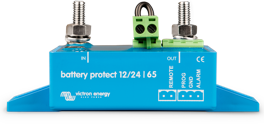
BatteryProtect
Discharging your battery too far will damage it. Adding a Victron BatteryProtect will disconnect the boat’s electronics when the battery voltage drops below a pre-set level. It will also automatically reconnect everything when the battery is sufficiently recharged.
There is more to a Victron BatteryProtect. The built-in shutdown delay ensures that vital electronics aren’t disconnected in error, i.e. when starting the engine causes a short drop in battery voltage.


Monitores de batería
El monitor de la batería es como un “indicador de combustible” de su batería. Registra la energía que se consume y se carga. El monitor de la batería calcula el estado de carga, la capacidad restante y el tiempo que falta para que se agote. La tensión de la batería no indica con precisión cómo de llena está la batería (especialmente si tiene una carga conectada), pero el monitor sí.
Los monitores de batería de Victron Energy hacen un seguimiento de datos históricos, como el número de ciclos de carga, la descarga más profunda y la tensión más alta y la más baja, entre otros. Le avisarán de condiciones críticas como tensión o carga baja e incluso pueden apagar la alimentación por completo para evitar un daño excesivo de la batería o encender un generador.
Victron ofrece monitores de batería con y sin pantalla, las versiones inteligentes (Smart) le permiten hacer un seguimiento de datos concretos y hacer ajustes en nuestra aplicación gratuita VictronConnect.
Casi todos los sistemas de litio necesitan un sistema de gestión de baterías (BMS) que pueda pasar información de la batería a todo el sistema. En esta ruta, es posible que no sea necesario un monitor de baterías. Véase el sistema de gestión de baterías (BMS) para más información. Ver todos nuestros monitores de baterías

La elección de los profesionales:
Aquí puede ver cuál de nuestros monitores de baterías se recomienda para el sistema del ejemplo

Boat Network
Keeping grips on all the systems on board can be a hassle. The solution: tie everything together in a single boat network using NMEA communication standards. Your boat network can include navigation equipment, tank senders, battery monitoring and much more. The status information can trigger alarms and shutdowns, adding to the safety on board. The Cerbo GX now supports the NMEA2000 out protocol, allowing you to monitor your boat’s network of systems from wherever you are.


Boat engines
Motor cruisers have one or two diesel engines to get from harbour to horizon. The engines are designed to run continuously, for days on end. They also come with high-output alternators to charge the engine batteries, drive fuel pumps, etc.
Once the starter batteries are recharged, the engines can also power the boat electrics and recharge the house battery. On motor cruiser you’ll find power hungry DC equipment such as anchor windlasses and bow thrusters. The engines have to be running before you can use them.


Boat Electronics
A motor cruiser is packed with dozens of electrical devices. These are all connected to the house battery. Think of:
- Boat control panel
- Log/depth sounder
- Chart-plotter
- Navigation / GPS
- Navtex
- Auto pilot
- All-band Radio
- Satellite comms
- Maritime traffic identification systems
- Navigation lights
- Pumps
- Windlass
- Bow thruster
- Fridge and freezer
- Air conditioning
- Blowers
- Interior lighting
- Music player

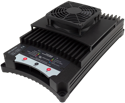
Buck-Boost
The Buck-Boost converter is used in dual battery systems, where the (smart) alternator and the start battery are used to charge the service battery (of equal or different voltages). The Buck-boost can be used in 12V or 24V systems and is suitable for both lead acid and lithium batteries.
Charging lithium batteries from the alternator
Alternators cannot be connected directly to most lithium batteries. A lithium battery will draw more current than the alternator can supply, which may result in alternator damage. A Buck-Boost DC/DC converter solves this problem: it acts as a current limiter between the alternator and the battery.
How to select a Buck-Boost? The current rating of the DC/DC converter has to be less than the alternator’s current rating. For example: pair a 50 Amps converter with a 60 Amps alternator. In the software the ideal throughput can be defined.
When the charging capacity exceeds the limits of the Buck-Boost, consider working with DC-DC generator(s) sized to the capacity of the battery bank.

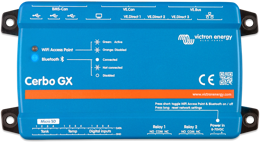
Cerbo GX
The Victron Cerbo GX is the communication-centre of your boat’s installation, allowing you to always have perfect control from wherever you are and maximises its performance. Simply connect through our Victron Remote Management (VRM) portal, or access directly, using the optional GX Touch 50 screen, a Multi Functional Display or our VictronConnect app thanks to its added Bluetooth capability.
The Victron Cerbo GX is an easy to use visual system. Instantly monitor the battery state of charge, power consumption, power harvest from PV, generator, and mains, or check tank levels and temperature measurements. Easily control the shore power input current limit, (auto)start/stop generator(s) or even set quiet periods to avoid starting the generator in the middle of the night. Change any setting to optimise the system, follow up on alerts, perform diagnostic checks and resolve challenges remotely. The Cerbo GX turns any power challenge into an effortless experience.

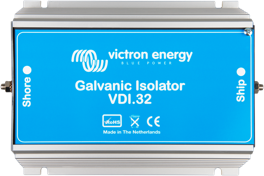
Galvanic Isolator
A galvanic isolator prevents electrolytic corrosion. The isolator is mounted directly behind the shore power connector on board. It blocks DC currents that might leak through the shore power earth terminal. These currents can cause corrosion to all metal parts under water, like the hull, propeller, shaft, etc. The galvanic isolator should have the same power rating as the incoming shore power.
It’s a misunderstanding that galvanic corrosion occurs only in metal and aluminium hulls. In fact it can occur on any boat as soon as a metallic part (the shaft and propeller) is in contact with water. Galvanic corrosion will quickly dissolve your sacrificial anodes, and attack the shaft, propeller and other metal parts in contact with water as soon as the boat is connected to the shore-side supply. It might therefore be tempting not to connect the ground conductor: this is however extremely dangerous because Ground Fault Current Interrupters will not work nor will a fuse blow in case of a short circuit to a metal part on the boat.
The safe option is to use a Galvanic Isolator for non-metal smaller boats, or use an isolation transformer for metal boats or boats with bigger systems.


Generator
The generator provides energy when shore power is not available and the boat’s engines aren’t running (or can’t supply enough power to meet the demand). The generator is usually supplemented with a inverter/charger and a battery bank. The batteries act as a backup and allow for quiet periods at night.
Thanks to Victron’s PowerAssist, the generator doesn’t have to be sized for the maximum load. You can use a smaller generator which is cheaper to install, uses less fuel and produces less noise. The inverter automatically bridges the potential gap between supply and demand with support of the battery bank.

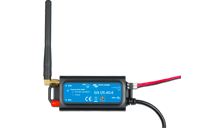
Módulos GX 4G
Un módulo GX 4G aportará conectividad a través de Internet a su sistema Victron Energy. Si su sistema está dentro del alcance de una red 4G, enviará datos al sitio web de VRM y usted podrá monitorizar su sistema desde su teléfono. El módulo añade seguimiento por GPS, grabación de sus desplazamientos y una geovalla (geo-fence) alrededor de la instalación. Recibirá un alerta por correo electrónico cuando el sistema salga del perímetro de la geovalla.
Victron Energy ofrece varios módulos 4G y el módem GlobalLink 520, que funciona sin cuotas mensuales ni suscripciones durante los primeros cinco años, y varios módulos 4G. Ver nuestros módems 4G Ver nuestro GlobalLink 520

La elección de los profesionales:
Aquí puede ver cuál de nuestros monitores de baterías se recomienda para el sistema del ejemplo

GX GSM Dongle
The Victron GX GSM is a 3G cellular modem that enables GX devices with mobile internet for the system and connection to the VRM Portal, allowing you to monitor your system from remote. When the boat is in range of a 3G network, it will send data to the VRM website and you can monitor the boat from your smartphone. The GSM module adds tracking the boat, recording your trips and putting up a geo-fence around the boat. You will get an alert via mail when the boat travels outside the geo-fence area.

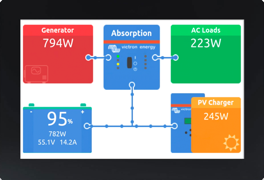
GX Touch
El Cerbo GX de Victron Energy es el centro de comunicaciones de la instalación de sus sistemas y le permite tener siempre un perfecto control desde dondequiera que esté y maximizar su rendimiento. La GX Touch 50 opcional acompaña al Cerbo GX. Su pantalla táctil de cinco pulgadas proporciona un resumen instantáneo de su sistema y le permite ajustar la configuración rápidamente.
Controle inmediatamente el estado de carga de la batería, el consumo de energía, la captación de energía de las placas FV, el generador y la red eléctrica, o compruebe las mediciones de los niveles del tanque o de la temperatura. Puede controlar fácilmente el límite de corriente de entrada de la alimentación del puerto, arrancar/detener de forma automática los generadores e incluso fijar periodos de silencio para impedir que el generador arranque en mitad de la noche. Cambie cualquier ajuste para optimizar el sistema, haga un seguimiento de las alertas, realice pruebas de diagnóstico y resuelva problemas a distancia con el portal gratuito Victron Remote Management (VRM).
El Cerbo GX es un sistema visual fácil de usar que convierte cualquier problema eléctrico en una experiencia fácil. Solo tiene que conectarse mediante nuestro portal Victron Remote Management (VRM) o acceder directamente con la pantalla GX Touch 50 opcional, una pantalla multifuncional o nuestra aplicación VictronConnect gracias a su opción de Bluetooth.

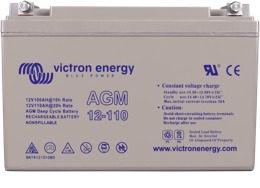
House battery
The house battery stores power for the boat’s electrical system. Motor cruisers typically have large power demands and the house battery should have a generous capacity.
For a house battery you can choose from two types: lead-acid and lithium. There are various reasons to favour one over the other. Here are a few common ones:
|
|

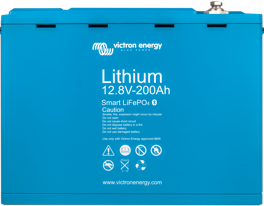
House battery
The house battery stores power for the boat’s electrical system. Motor cruisers typically have large power demands and the house battery should have a generous capacity.
For a house battery you can choose from two types: lead-acid and lithium. There are various reasons to favour one over the other. Here are a few common ones:
|
|


Inverter/Charger
On motor cruisers you’ll need an intelligent inverter/charger that automatically switches between various sources to cater for all power needs.
In the marina shore power will be used to feed the boat’s AC grid and charge the batteries. When no shore power is available, the batteries will power both the DC and the AC grid. Power can be drawn from the boat’s engines while sailing. If the power demand gets too high or the batteries get low, the generator will kick in to power the load and charge the batteries.
- Victron inverter/chargers come with a handful of outstanding features:
- PowerControl: automatically manage battery charging to prevent an overload of the generator or shore power.
- PowerAssist: uses the battery as a buffer to assist the shore power during peak power demand.
- Perfect power: even sensitive devices run flawlessly on the pure sine wave power.
- High peak-power: use motorised equipment without overheating.
- Low self consumption.
Thanks to PowerAssist, the generator doesn’t have to be sized for the maximum load. You can use a smaller generator which is cheaper to install, uses less fuel and produces less noise.
If you don’t have a generator on board, a Multiplus is all you need. With a generator on board a Quattro is the better choice.
We strongly recommend 24 Volts for new boats. The higher voltage is simply a better choice when it comes to meeting the power demands of a motor cruiser. If your boat’s system is based on 12 Volts, select a 12 Volts unit instead. If you have dissimilar battery banks, consider charging them using a DC-DC converter, or have it power several dissimilar appliances with a different voltage than the house battery.
Generally speaking, a 3 kVA unit will be big enough, unless the power consumption is higher than average. For example: when you have an air conditioner on board. If this is the case, choose a 5 kVA unit.

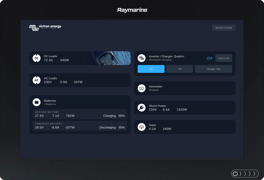
Integración de pantalla multifuncional GX
The Victron integration between our GX range and several leading Multi Functional Display manufacturer brands enables you to easily connect an MDF to the heart of your power system such as the Cerbo GX, or the GX enabled MultiPlus-II GX. Once connected you can easily monitor and control your boat’s power system, right on your Glass Bridge.

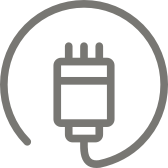
Shore Power
Usually shore power is available in the marina; it is used to run large AC equipment on board and recharge the batteries. Larger boats need a three phase supply. Sometimes shore power can’t provide enough power to cater for the total AC load of the boat. It might also just be single phase.
Often shore power is limited in how much power you can draw, i.e. just 10 Amps. Berths with higher ratings might not always be available. Victron inverter/chargers allow you set a maximum shore power current. Now you can charge your batteries and turn on any equipment without blowing a fuse. Thanks to Victron’s PowerAssist, the generator and batteries can automatically bridge the gap between supply and demand.
Sometimes shore power is less than perfect. You might run into voltage drops if you’re at the far end of the harbour. There could also be power surges, which could harm sensitive equipment on board. Victron’s inverter/chargers smooth out these problems and turn bad power into perfect power.

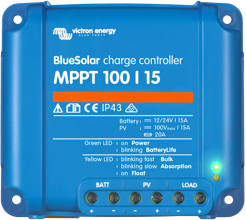
Solar charger
Solar panels won’t be able to cover all the power needed, but they can reduce the running time of the generator and fuel costs.
A solar charger - also called MPPT controller, harvests the power from the solar panels to charge the house battery. Solar chargers have the same charging cycles as our regular, fully automatic, battery chargers. When your boat is moored without shore spower, solar power is a great way to keep the batteries charged.
In a marine environment, the performance of solar panels changes constantly. Victron’s solar controllers use ultra fast maximum power point tracking to squeeze up to 30% more power out of your panels.
See our Solar Calculator to size the solar panels and select a MPPT charger

Solar panels
Solar panels won’t be able to cover all the power needed, but they can reduce the running time of the generator and fuel costs. Victron offers a wide range of highly efficient solar panels that are just perfect for marine use.

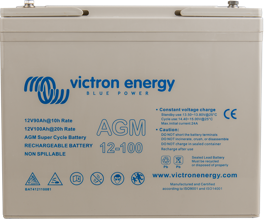
Starter Battery
The starter battery is needed to start your boat’s engines. These batteries are different from house batteries and engineered to deal with a large discharge current. The starter batteries should be ready to go. Always use a BatteryCombiner to connect the starter batteries to the rest of the electrical system; it prevents an accidental drain of power.


GX Touch
The GX Touch 50 display allows you to have an instant overview of your system and adjust settings in the blink of an eye. Simply connected to the Cerbo GX with one cable, its super slim 5 inch waterproof design and its top-mountable setup bring a lot of flexibility when creating a crisp and clean dashboard.

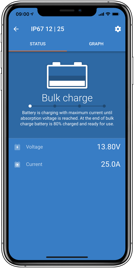
VictronConnect
All Victron products on your boat can be monitored and controlled from the palm of your hand. Just connect the VictronConnect App via Bluetooth and you’ll have direct access to values like battery voltage and current. You can also turn devices on or off, as well as change their settings.
See what the VictronConnect app can do
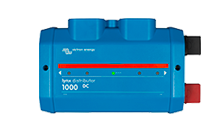
Lynx Distributor
The Lynx Distributor is a modular DC busbar, with locations for four DC fuses. It will monitor the status of each fuse, and indicate its condition with a LED on the front. When connected to a Lynx Smart BMS or Lynx Shunt, the status of the fuses will be visible in VictronConnect and VRM (when the Lynx Smart BMS is connected to a GX-device).
Multiple Lynx Distributors can be used to connect all the DC-loads and charge sources on one side of the BMS, on the other side, a Lynx Power In (without fuses) or another Lynx Distributor (with fuses) can be used to connect the battery bank to the modular busbar.
Lynx Distribution system
This product is part of the modular Lynx busbar system that also provides the Lynx Smart BMS, a dedicated Battery Management System for Victron Lithium Smart Batteries (for non Victron Lithium batteries, use the Lynx Shunt).
Ver todos los modelos Lynx
La elección de los profesionales:
Aquí puede ver qué producto se recomienda para el sistema del ejemplo

VRM - Victron Remote Management
Monitorización y gestión
Monitorice y gestione sus sistemas Victron Energy desde cualquier lugar y detecte posibles problemas de forma temprana fijando alertas y alarmas. Con VRM siempre tiene perfecto control desde dondequiera que esté.
VRM funciona con un dispositivo GX, como el Cerbo GX con conexión a Internet, el GlobalLink 520 o el GSM LTE 4G para sistemas más pequeños.
Rastreador
Monitorice el estado de carga de la batería, el consumo de energía, la captación de energía desde los paneles solares, el generador y la red eléctrica en tiempo real. Optimice la captación y el uso de energía con gráficos históricos e informes analíticos detallados. Detecte posibles problemas de forma temprana estableciendo alertas y haciendo un seguimiento de las alarmas para evitar un fallo definitivo del sistema.
Gestión
Puede controlar fácilmente el límite de corriente de entrada de la alimentación del puerto, arrancar/detener de forma automática los generadores e incluso fijar periodos de silencio para impedir que el generador arranque en mitad de la noche. Con VRM puede cambiar cualquier ajuste, hacer un seguimiento de las alarmas, realizar comprobaciones de diagnóstico y resolver problemas desde dondequiera que esté.
Ver todos nuestros dispositivos GX
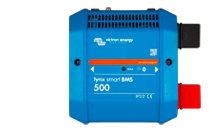
Lynx Smart BMS
El Lynx Smart BMS es un sistema de gestión de baterías (BMS) específico para las baterías de litio Smart de Victron (para baterías de litio que no sean de Victron, consulte la siguiente información). Hay muchos BMS para nuestra serie de baterías de litio Smart Lithium, pero el Lynx Smart es la opción más completa y que más funciones tiene. Sus principales características son:
- Contactor integrado de 500 A, usado como mecanismo de seguridad auxiliar y también disponible como interruptor controlable a distancia de los sistemas principales.
- Monitor de baterías, que indica el porcentaje del estado de carga, entre otros datos.
- Señal de prealarma: proporciona un aviso antes de que el sistema se apague debido, por ejemplo, a una celda baja.
- Bluetooth para usar con nuestra aplicación VictronConnect, para configuración y monitorización.
- Monitorización local y a distancia con un dispositivo GX de Victron, por ejemplo el Cerbo GX.
Sistema de gestión de la batería
El sistema de gestión de baterías (BMS) exclusivo protege las baterías de litio Smart de Victron de las descargas profundas, la sobrecarga y las temperaturas elevadas. Cuando se superan los valores críticos, el BMS actúa inmediatamente: las cargas se desconectan físicamente en caso de descarga profunda y el proceso de carga se detiene cuando hay riesgo de sobrecarga. Las altas temperaturas activan la finalización inmediata de los procesos de carga y descarga.
Control de baterías
El Lynx Smart BMS cuenta con monitorización de baterías integrada; no se necesita un monitor de baterías separado. A través de Bluetooth, la bancada de baterías puede monitorizarse con VictronConnect cuando se conecta a un dispositivo GX, y también con VRM, nuestra solución de monitorización a distancia.
Sistema de distribución Lynx
Este producto forma parte del sistema de embarrado modular Lynx que también cuenta con el distribuidor Lynx, que es un embarrado CC modular con cuatro fusibles CC, y que monitoriza su estado en VictronConnect y VRM y otras conexiones CC para manejar la distribución, los fusibles, la monitorización de la batería y la gestión de la batería de litio.
Baterías de litio que no son de Victron
El sistema de embarrado de Lynx también puede usarse para distribución CC y monitorización de baterías de litio que no sean de Victron. En ese caso, sustituya el Lynx Smart BMS por el Lynx Shunt VE.Can para monitorizar cualquier otra batería. Ver todos los modelos Lynx

La elección de los profesionales:
Aquí puede ver qué producto se recomienda para el sistema del ejemploEl consumo de energía es diferente para cada embarcación y para cada propietario. El plan de Energía Óptima siempre debería diseñarse con las características específicas del barco en mente. Sin embargo, para empezar, se muestran dos ejemplos (con consumo diario de energía normal y superior) de plan de Energía Óptima para un barco a motor.
Tenga en cuenta que hay muchos más factores que intervienen en el diseño y la instalación de la solución óptima para usted: su representante de Victron Professional estará encantado de ayudarle con eso.
La magia del MultiPlus: generador pequeño, alta potencia.
La visión de los expertos: ¿litio o AGM a bordo?
Haga las conexiones correctamente con Cableado sin límites
Mostrar más
Vea el rendimiento de su sistema desde su puente de mando de cristal
Ver todos nuestros productos náuticos y más configuraciones.
Información en tiempo real y control completo con nuestra aplicación VictronConnect
Busque su distribuidor local
Nuestra bien establecida red de profesionales locales de Victron trabaja para ayudarle a encontrar una solución óptima para su problema.
Puede contar con nuestra asistencia en todo el mundo
En Victron creemos que es esencial que los clientes reciban atención y asistencia de forma rápida y competente. Por esta razón, nuestra red global de profesionales de Victron tiene el mayor nivel de conocimientos técnicos y el compromiso de hacer las reparaciones necesarias lo antes posible.
Para que pueda emprender o continuar su viaje, a dondequiera que se dirija.

4 personas